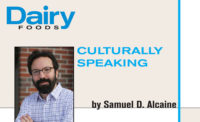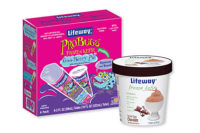
Rounding the Next Bend
by Shonda Talerico Dudlicek
Flexible packaging continues to offer convenience,
safety and shelf appeal.
The evolution of flexible
packaging continues with smart packaging, radio frequency identification
and retort packaging.
For dairy products, flexible packaging ranges from
thinner, stronger films to biodegradable films to on-the-go packages that
are lightweight and recloseable.
“Dairy products pose no problem for packaging in
flexible,” says Andrew Mykytiuk, editor in chief of Flexible Packaging, the magazine
of the Flexible Packaging Association. “The beauty of flexible
packaging is that it can be custom configured for virtually any
application, be it milk in an aseptic pouch, which is popular in Canada,
Europe and Asia, or be it yogurt packaged in a slim plastic
tube.”
On-the-go products, especially portable snacks, are
popular, says Terri Cubitt, market manager of cheese and dairy at
Minneapolis-based Curwood Inc. “Because of this increasing trend,
packaging that is easy to open, providing quick access to the product, is
in high demand,” Cubitt says. “Curwood has been very active in
developing films and technologies for on-the-go concepts. Convenience
technologies — including Curwood’s EZ Peel®, EZ Peel/Re-Seal®, FancyCut®, IntegraTear® and IntegraScore® — all
function to make our packaging more consumer friendly.”
The use of more transparent polypropylene film in ice
cream offers product visibility, a superior moisture barrier and resistance
versus paper, says Jon Knight, director of the packaging, label and
technical business for Treofan America, Winston-Salem, N.C.
“The switch from ‘paper-based’ ice
cream tubs to polypropylene tubs with in-mold labels offers far superior
graphics and additional marketing opportunities, as ‘plastic
tubs’ are reused in the home,” Knight says.
Treofan has developed a full range of flexible
solutions including white opaque, metallized and clear films for multi-lane
novelty and single-lane sandwich machines; and five films for in-mold
labels. The company, which manufactures polypropylene films for flexible
packaging and in-mold labels for dairy applications, offers white opaque
films for novelties and sandwiches and a transparent OPP developed
specifically for multi-lane novelty machines.
Scholle Corp., Irvine, Calif., has developed a new line
of low-acid webbed aseptic filling machines, including a new generation of
high-speed web fillers and 10-head fresh and extended-shelf-life rotary
fillers. The inventor of bag-in-box packaging, Scholle was the first to
develop filling equipment for aseptic, fresh and ESL products.
“Our fully integrated manufacturing gives us the
unique ability to control the quality and supply of our products,”
says Paul Dean, commercial director of food at Scholle.
Aseptic bag-in-box packaging is combined with the
convenience of a range of dispensing taps. “The technologies to
support this trend are found in the area of aseptic filling and fitment
design, which delivers products that can withstand the aseptic process
while maintaining functionality. There has been an overall improvement in
flexible packaging for the food industry from fresh to ESL and from ESL to
aseptic,” Dean says.
Scholle’s new 800FT fitment offers tamper
evidence combined with low-acid fill-dispense features and replaces a
two-fitment bag, the market standard, with a one-fitment bag. “This
innovative new product offers cost savings and increased value to both
processors and end-users,” Dean says.
Bright Future
Smart packaging, which detects variable data such as
time and temperature, give the retailer as well as the consumer information
as to the product’s shelf life, Mykytiuk says.
Videojet Technologies’ DataFlex printer offers
significant improvement over hot stamping and other thermal transfer
products due to reduced downtime and increased reliability, superior cost
efficiency and intuitive touchscreen user interface, says Doug Grady,
product manager of North American thermal transfer overprinting at Videojet
Technologies Inc., Wood Dale, Ill. “This printer helps customers
achieve uptime peace of mind across many industries that use flexible
packaging,” Grady says.
Radio frequency identification (RFID) has changed
flexible packaging, Mykytiuk says. Previously, expensive labels had to
affixed to the package, but now ink companies offer special conductive inks
that allow the RFID tag to be printed in-line and at high speeds right on
the package. “This is expected to lower cost by as much as 90
percent, making RFID viable for flexible packaging,” Mykytiuk says.
Shrink-film labels continue to dazzle the dairy
industry as packaging displays vibrant color schemes. “Another
popular use of flexible is shrink-film labels used to add bold colors and
eye-catching shelf appeal to dairy products such as crème or milk
sold in shaped PET bottles,” Mykytiuk says.
SleeveCo Inc. produces full-body decorative
shrink-sleeve labels and stretch-sleeve polyethylene labels as well as
stretch-sleeve application equipment. The Dawsonville, Ga.-based company
recently rolled out a new high-speed stretch-sleeve applicator.
“We’ve tooled our facility with
state-of-the-art narrow and medium web rotogravure printing presses. Our
narrow and medium width presses allow us to affordably accommodate the
private label-driven trend of increased SKUs,” says Brian Metzger,
director of business development. “Specifically, we are able to
offer award-winning rotogravure printed sleeves, with low upfront costs,
short minimum runs and quick speed to market.”
Shrink-sleeve labels have grown 10 to 20 percent over
the past few years, due to the advantage of this label to differentiate the
product on the shelf, says Terry Copenhaver, marketing manager, Alcoa
Flexible Packaging, Richmond, Va. “Shrink sleeves are the only label
available that can achieve a 360-degree label from top to bottom on
contoured containers. In addition to the high gloss of the labels, there
are new ink technologies such as pearlescent inks, thermochromatic inks and
inks that flip from one color to another when you move the container back
and forth,” says Copenhaver, noting that Alcoa holds the long-term
contract for Nestlé Nesquik products.
Farmingdale, N.Y.-based Seal-It Inc. offers full
heat-shrinkable labels and tamper-evident bands for the dairy industry,
including labels for the McDonald’s Milk Jug.
“We developed our own machinery and printing
presses, both roto and flexo systems, that can accommodate the artwork and
label,” says Sharon Lobel, president and chief executive officer.
Seal-It has thermographic inks, which yield vibrant colors and options for
fluorescent and metallic inks. The company’s graphics department will
make a product sample showing the label “as it sits on the
table,” Lobel says.
Going and Growing
Dairy processors want flexible packaging that is
consistent and reliable, says Jim Mallon, vice president of sales and
marketing at MRI Flexible Packaging, Newtown, Pa., which manufactures
shrink labels and roll-on shrink labels.
Processors are looking for packaging that
differentiates their products and offer the consumer value, using packaging
to drive brands and grow the business. “There remains a strong trend
toward developing convenient, on-the-go products,” Cubitt says.
“Dairy processors want flexible packaging to convey a message to the
consumer that their product is more convenient.”
Dean Foods’ Milk Chugs revolutionized the dairy
industry, says Copenhaver, and since then the switch to plastic bottles
with shrink labels has been nearly universal. “The dairy industry has
made the move nearly across the board. Dairy processors realize that
repackaging flavored milk, which has shelf appeal from the highly
decorative label, will increase their sales.”
More and more, dairy products are moving toward plastic
bottles and splashy graphics, Lobel says. “Paper and cardboard have
been around for 60 years. This is the way of the future. More products are
using more elaborate treatment,” she says.
High-quality graphics always attract consumers to buy,
says Bob Scherer, vice president of CL&D Digital, Delafield, Wis.
“A high-quality appearing package makes their product noticeable on
the store shelf that the consumer likes and will continue to buy,” he
says.
Metzger says the rise in demand for private label dairy
products, as well as their need to be competitive with national brands, has
prompted regional dairy processors “to run significantly more SKUs
— and in more shapes and sizes. To accommodate this rise in
SKUs, these dairies are asking their packaging suppliers for lower upfront
costs, lower minimum order quantities, and much quicker speed to
market.”
“Consumer demand for functionality and
convenience is now being met with resealable single-serve packaging which
fit in cup holders,” he says. “The next battlefield is bottle
shapes and label graphics. Consumers are being swayed by
‘premium’ label graphics and bottle shapes.”
Seal-It can manipulate the design so it follows the
curve of a bottle. “Nobody likes a straight bottle. If it has a
curve, that’s what they want for the label,” Lobel says.
“Consumers buy products that look appetizing. If you’re selling
milk, then you want the label to look like it’s so appetizing, and
then it’s a win-win situation. Paper cartons can’t give that
off. Paper will not look like a portrait.”
Reclosable packaging that utilizes a zipper or
resealable pouch is increasingly popular, says Grady. “Consumers want
a cost-efficient, high-quality, and environmentally friendly package that
generates minimal waste.”
What consumers want most from their packaging is
convenience, Mykytiuk says. “The consumer demands convenience. The
consumer wants the product to be in an easy-to-open package, and the
consumer wants recloseability. In the past five years, innovations in
press-to-close zippers, slider zippers and a wide array of fitments have
made flexible packaging more consumer friendly than ever before,” he
says.
Consumers demand fast, economical, portable snacks and
meals, Cubitt agrees. “Products must be easy to prepare, and be used
on the go,” she says. “As a result, flexible packaging must be
easy to open and re-close.”
Copenhaver points to the growth in milk sales for
McDonald’s as an excellent example. “Now, fast food companies
are even realizing that consumers would prefer to purchase milk in a
plastic bottle that fits in a cup holder vs. the carton,” Copenhaver
says.
Extra Protection
No packaging discussion would be complete without a
discussion of tamper evidence.
Mykytiuk says flexible packaging is tamper evident by
its very nature. “You have to tear the package to open it, thereby
putting any subsequent user on alert that it has been opened,” he
says.
Scherer agrees: “If a package has a poor seal or
a hole in the seal, the customer can reject it at the store.”
The Bioterrorism Act, due to take effect in December,
will require that all packaging must be trackable and traceable.
“While food safety has always been a primary concern for food
manufacturers, 9/11 made it an even bigger concern,” Grady says.
“Consequently, there is an increasing demand for tamper-evident
closures. We will see accelerated safety innovations in flexible packaging
due to the legislation.”
Convenience technologies like Curwood’s EZ Peel,
EZ Peel/Re-Seal and IntegraScore not only provide easy access to the food
product, they all function to assure the packages barrier is not
compromised, Cubitt says. “Food safety is certainly a concern for
consumers today and tamper-evident packaging can provide them peace of mind
that their food product is protected,” she says.
Scholle packaging incorporates various tamper-evident
closure options into products, Dean says. “The bag-in-box package
gives consumers the added confidence that the inner package is completely
encased by an outer container. The combination of a hermetically sealed bag
in a durable outer container provides a strong packaging solution,”
he says.
The very nature of bag-in-box provides added assurance
of product integrity and its safety from contamination, Dean says.
“One key attribute of interest is that the Scholle package is never
open to the atmosphere, as it is a sealed system during filling and
dispensing,” he says.
Metzger says SleeveCo is receiving more requests to
extend its full-body shrink-sleeve labels up and over the closure.
“This provides tamper evidency and/or additional tamper
evidency,” he says. “The tamper-evident portion of the shrink
sleeve is perforated to come off when the bottle is opened. The full-body
sleeve remains.”
Tamper-evident bands are now a selling point, Lobel
says. “They’re not only used for their intended purpose. If
consumers are choosing between a product that doesn’t have a
tamper-evident band and one that does, the most consumers will buy one with
a band,” she says.
The more the tamper-evident band stands out, the
better, Lobel says, and this can be achieved by matching the band to the
product packaging. “You can get a combination in one, like a
horizontal or vertical tamper-evident band around the neck of the
package,” she says. “Like accessories to an outfit, you can
coordinate it with the label.”
Shonda Talerico Dudlicek is a freelance journalist and
a former managing editor of Dairy Field.
$OMN_arttitle="Rounding the Next Bend";?>

